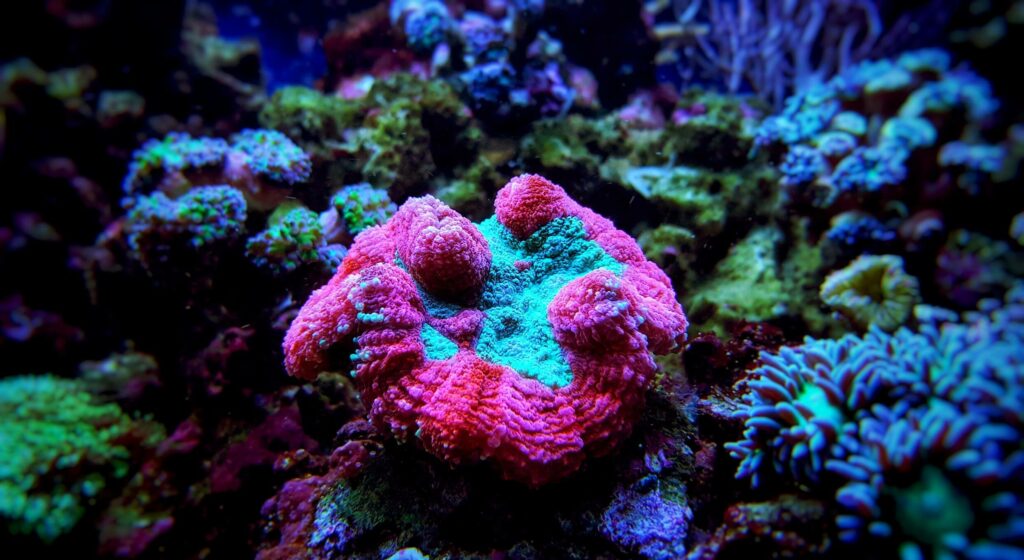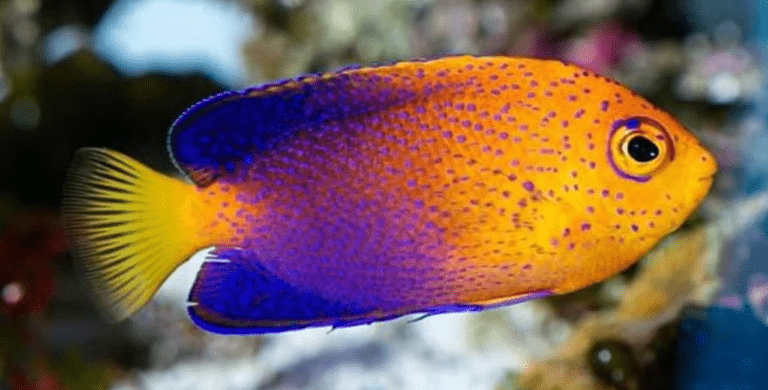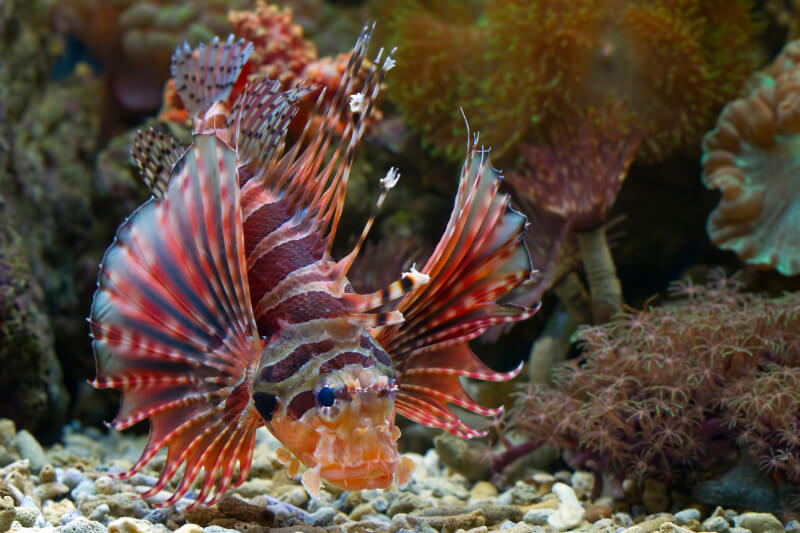Quick Facts
| Scientific Name: | Lobophyllia hemprichii, L. hawaii, L. corymbosa |
| Other Names: | Lobos, Lobed brain coral, Carpet coral, and Brain coral |
| Water Flow: | Low-to-moderate, 20 to 40 times turnover |
| Compatibility: | Banggai Cardinalfish, Firefish, Royal Gramma, Six Line Wrasse, Tank-Raised Clownfish |
| Size & Growth: | 4-6 inches |
| Care: | Intermediate due to soft tissues |
| Feeding: | Phytoplankton, zooplankton, and zooplankton-sized powders, frozen mysis shrimp or brine shrim |
| Water Parameters: | 73-84F, 8.1-8.4pH, 8-12dKH, 1.024-1.026SG, Calcium 400+ppm, Magensium 1300ppm |
| Tank Size: | 10 gallons (min) |
| Lighting: | Low-to-moderate, 80 to 120 PAR |
| Propagation & Fragging: | Difficult but doable |
Who wouldn’t want a coral in their aquarium that goes by the name of Tequila Sunrise Lobo? The Lobo Coral is one of our favorites because of its vibrant colors and patterns and why not, also because one of its species has the name of a popular drink in parties!
This brain coral is usually in high demand and we are sure it will be a great addition to your tank for years to come as long as it is properly cared for.
One of the main challenges is caring for its soft tissue which is usually damaged during shipping but once you get past this, then you will be in great position to have a good looking coral for many years!
We enjoyed writing this guide so you can have everything you need from tank requirements, to diet and fragging tips. Enjoy!
Species Summary
The Lobo Coral is an LPS known as Lobophyllia coral, Lobos, Lobed brain coral, Carpet coral, and Brain coral, and it is part of the Lobophylliidae family. It can be found in a range of species and genera, with the most common being Lobophyllia hemprichii, L. corymbosa, and L. hawaii.
This coral is naturally found in the Pacific Ocean’s tropical waters, such as Indonesia, the Great Barrier Reefs, Australia, Fiji, and Japan. They are usually found growing vertically and horizontally on the front or upper reef slopes.
Appearance
The Lobophyllia Coral can be found in a range of colors, textures, and patterns, allowing you to have your pick of the bunch for your aquarium. Textures vary per coral and range from smooth to bumpy, and colors include green, red, blue, burnt orange, tan, brown, and gray.
The Lobo has similarities to certain Acans, Blastomussa, and Scolymia species, so you want to pay attention to corals that have been mislabeled by retailers. If you enjoy brain corals, you may want to look at the aforementioned to accompany your Lobo Coral.
Popular Lobo Coral Species
You can choose from several types of Lobo Coral species for your aquarium, with the most popular species being the following.
Toxic Mouth Lobo
Kinda a cool and scary name, isn’t? The Toxic Mouth Lobo comes in several bright colors, and some shades even look neon.
For instance, one coral may feature a dark blue body and a neon green center, while another may have an orange body with purple edges and a green center. Some Toxic Mouth Lobos also have a bumpy texture.
Tequila Sunrise Lobo
This one is the life of the party! The Tequila Sunrise Lobo’s name was inspired by the alcoholic drink, and it may feature a dark brown body with a green center and purple underneath the edges.
Another color scheme includes a pale pink body with a blue center and light green edges, allowing you to add a coral that is bright but not neon to your tank.
Neon Orange Lobo
Great choice for dark places! The Neon Orange Lobo lives up to its name with its bright ring-shaped body and dark center. Depending on the light, the center looks blue or purple. It also features a noticeably pimply body.
Lobo Coral Care
The Lobophyllia Coral usually requires moderate but special care because of its fleshy soft tissues, so it is a more suitable choice for intermediate and experienced hobbyists.
Tank Size
The minimum recommended tank size to host your Lobo Corals is 10 gallons because that provides them with enough space to grow (check our 4 Best 10-Gallon Tanks). If you are adding multiple colonies to your tank, you may want to increase the size to provide a safe environment. Some hobbyists place their coral in tanks of up to 50 gallons.
Water Parameters
Keeping a great water chemistry is essential for your coral’s coloration, growth, and survival. Fortunately, the Lobo does not have any weird or unusual requirements so the standard guidelines below will keep them happy.
- Water temperature: 73-84 degrees Fahrenheit (22-29 degrees Celsius)
- pH levels: 8.1-8.4
- Water hardness: 8-12 dkh
- Specific gravity: 1.024-1.026
- Calcium: 400+ ppm
- Magnesium: 1,300 ppm
- Salinity: 35 g/L
- Phosphate: 0.05-0.1 ppm
- Nitrate: 5-10 ppm
Tank Setup
When setting up your coral tank, add a sand bed or substrate to the bottom. Rocks or other hard surfaces can be provided as long as your coral is not at risk of falling off.
Placement
Your Lobophyllia Coral can be placed directly on the sand bed, substrate, or hard surface at the bottom of the tank. They should be kept away from other coral species, rocks, and tank decorations because too much touching can lead to injury.
Lighting
Low-to-moderate lighting, such as 80 to 120 PAR, provides enough light without causing damage to your Lobos. The coral also does well under LEDs that provide sufficient blue light.
Filtration & Water Flow
A high water flow can lead to retracted polyps or an exposed skeleton. It can also make it difficult for your coral to capture its food. Providing a low-to-moderate flow 20 to 40 times turnover safely cleans your coral while channeling food in its direction.
Acclimation
When acclimating your Lobo Coral, it is best to start with lower lighting, which would be closer to 80 PAR. Once you see how your coral reacts, you can adjust the lighting a little higher if necessary. It should be a gradual change to avoid shocking your coral.
You also need to double-check the water parameters to ensure each level is within the recommended range.
Author Note: Remember, your coral may have traveled in a styrofoam container and may be stressed from the trip, so it needs patience and time to adjust to its new surroundings.

Why Is My Coral Losing Color?
If you notice your Lobophyllia Coral losing its color, this could be a sign that an important trace element is missing from its water, such as calcium or strontium. Other reasons could be as follows:
Hot Water. High tank water temperatures can bleach your corals. In the wild, rising ocean temperatures lead to coral bleaching. Anything over 80°F can harm or push away zooxanthellae, making corals lose their color because their exoskeleton can’t keep the hue intact.
Chemical Inbalance. High nitrates or phosphates from fish waste can dull coral colors. Do frequent water changes to control these chemicals and use a skimmer for a vibrant tank!
Missing Alkalinity. If your corals keep bleaching despite light adjustments, check water alkalinity. Alkalinity levels below 7-10 dKH won’t harm corals but can fade their colors over time. Regularly monitor alkalinity and other chemical levels, and boost it when it’s low for happy, colorful corals.
Light Issues. Light intensity is key for coral color. Tiny algae, zooxanthellae, live in corals, using light for pigments. But here’s the thing: different corals need varying light levels. Too much or too little can make algae die, leaving corals pale. So, it’s like a light dance to keep corals gorgeous!
Size & Growth Rate
Lobo Corals grow slowly and if you are buying it from a retailer, they will be smaller than 1.5 inches. Eventually, each individual coral can grow to 4-6 inches.
For those interested in the origins of these corals, they can grow up to several feet wide on a natural reef.
Feeding
Your Lobophyllia coral should be fed several times a week to encourage good health and faster growth.
Lobo Corals rely on zooxanthellae for their nutrients and also benefit from direct feeding. You can provide phytoplankton, zooplankton, and zooplankton-sized powders, as well as frozen mysis shrimp or brine shrimp and commercial pellets and powders. Lobos also like to dine on oyster eggs and other finely diced seafood.
When you are ready to feed your coral, do the following:
- Prepare a small amount of food and place it in a syringe or turkey baster.
- Squirt the water in the direction of its mouth rather than right into the coral.
- Turn the flow off for about 10 minutes, and be sure to give your coral time to capture and eat its food.
Compatibility
Lobo corals are semi-aggressive and might extend their sweeper tentacles to attack other corals if they feel threatened. Your coral also launches mesenteric filaments at night that can leave the other corals dead. It even retracts the mesenteric filaments to hide evidence of its aggression. This is another reason to keep your Lobos away from other coral species.
When it comes to saltwater fish, there are several species that are compatible with your Lobophyllia Coral.
You do not have to worry about these fish bothering or nibbling on your coral.
Propagation and Fragging
Lobophyllia Corals are hermaphrodites and reproduce sexually and asexually. In their natural habitat, they release eggs and sperm at once. The fertilized egg transforms into a free-swimming planula larva. Next, the planula larvae settle onto the substrate and become a plankster, forming a tiny polyp. The tiny polyp starts to discharge calcium carbonate and turn into coral.
In captivity, you would need to frag the coral yourself, which is not easy because of its soft tissue and dense skeleton. This does not mean it is impossible to frag your coral. You just have to be patient as it grows and careful during the fragging process. The below is a simplified list from our Coral Fragging Guide.
- The first thing you want to do is choose a healthy, mature coral to frag. You need a coral that has already separated into an individual polyp.
- Next, you want to gather the necessary supplies, such as a Dremel tool or tile saw and iodine solution or a specialized coral dip.
- Carefully use your tool to cut the skeleton between the individual polyps. You want to make a clean cut in two halves or four quarters.
- Dip the fragged coral segment into the iodine solution or coral dip to heal any injuries it may have sustained during the cutting.
- Place the segment into a separate tank, also known as a fragging tank, as it heals.
- Once it heals, place your fragged coral in its designated spot in your aquarium.
Author Note: Remember, the Lobo is a slow-growing species, so you may not be able to frag your coral often. This is why many purchase their coral from hobbyists rather than from a store. Some hobbyists frag and sell fully grown coral to create more space in their tanks.
It’s Decision Time
Now that you know more about Lobo Coral care, it’s up to you to decide which and how many of them to add to your saltwater aquarium.
Brain Corals are known to live 900 years! They are fascinating creatures because they instantly change the appearance of your tank by adding lots of vibrant colors and patterns without too much work (aside from the shipping challenges).
We hope this guide helped you in your decision to add a Lobo Coral and if you already have one, you are now more knowledgeable! Feel free to check our other Coral Care Guides and if you will show off your coral in social media, please tag us on Facebook.




